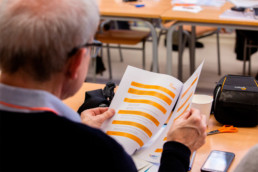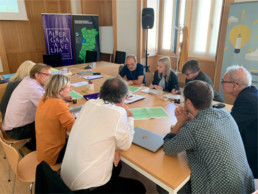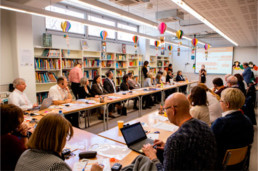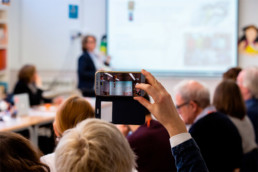The ON BOARD transfer process has been an intensive learning and exchange experience, with the results among project partners never more apparent. However, just like coming to the end of a good run, it is clear to all that it’s now time to stop, catch our collective breaths, and to reflect and take in what has been learnt in order to re-start again with a fresh set of legs and new outlooks.
The ON BOARD project has gathered together cities of different sizes and regions, which, as in all URBACT Networks as they develop, leads to as many discoveries of transfer challenges as learnings about different personal, professional, cultural, political, and legal contexts of those involved for educational innovation.
The transfer methodology that facilitates the bringing together of cities’ representatives and their target people has created the conditions for building the transnational Educational Innovation Network as an education hub helping cities to promote projects in a collaborative and fruitful way involving a diversity of local stakeholders.
The process, tools used, and the interactions generated at face-to-face meetings and in virtual spaces have been as important for the Good Practice Transfer as the actual learning of educational innovation-related topics themselves. Peer reviews, joint planning sessions and development of creative and innovative project proposals engaged participants of different profiles and education experiences, they not only expanded horizons of thinking, but enriched multi-disciplinary learning and skills-building. Indeed, when the pandemic burst, and we unavoidably had to turn to the use of online work tools and protocols, this helped boost each ones’ communication and technology skills, which enabled us to keep progressing in our network activities.


Results achieved and lessons learnt
Now that the project is reaching the end, and with the perspective of the transfer process as a group of learning cities, we are proud to present key learning and achievements in this digital report. Also, the difficulties and pitfalls, which often happen to be the most interesting lessons to learn from. Individual city results can be seen in the Cities’ dedicated section of this document. Below are the overall conclusions and reflections of the Educational Innovation Network transfer process.
Check out the main impacts of theON BOARD journey
The ON BOARD project has helped a number of key local stakeholders who have a role to play in education to sit down together and purposefully explore what they think about educational innovation in their city. The numerous encounters at transnational and local level gave them valuable time for such sharing, learning and reflection. What’s more, the transnational 2 to 3-day intensive learning and exchanges abroad helped participants from the same city to meet in unexpected places such as on-site visits, terraces during coffee breaks or even in airports, which helped them get to know each other in a different environment, outside their normal work-day contexts and routines. Not surprising in the least, this led to relaxed, free-flowing thinking and boundary-breaking possibilities (new cooperation across municipal departments, for example).
The Educational Innovation topic raises much interest among different groups. Most agree on the need for education systems to catch up with the state-of-play about learning tools and methods and to provide children and youths with skills and capacities beyond what the curricula teaches in the classroom. The ON BOARD experience proves that Municipal governments can make a difference in framing the discussions, encouraging community inter-actions, generating cooperation across sectors, and supporting knowledge flows amongst the key education agents in the city to do just that. Fostering collaboration and sharing moments is an essential practice for learning and improvements in all of the above.
Cooperation and teamwork between education centres and between schools and other local agents is opening up the classroom to the neighbourhood and the city. There have been first and important steps towards building a local Network at the district level -Nantes, Poznan, Halmstad and Tallinn- or city level – Viladecans, Albergaria-a-Velha by means of concrete projects to test-drive their first collaborative experiences.
The first results of the networking experience have translated into concrete Pilot Projects in Primary and Secondary schools, in collaboration with external stakeholders. These Pilots not only aim to help teachers and others enrich the education ecosystem with new ideas and practices, but to expose students to complex and real-life situations for which they will need -in the spirit of lifelong learning – even more learning and 21st Century skills-building. Students developing measurement devices in the framework of an environmental project within their neighbourhood; children and adolescents exploring and sharing their emotions and feelings; schools participating in projects led by the European Space Agency; Master students talking about healthy habits and how they impact on learning capacities, are but just a few.
Commitment -mostly from mayors and vice mayors- and the capacity to mobilise local people and resources, has been key to project success in ON BOARD, as well as in other URBACT Transfer Networks. This is particularly true for smaller partner cities where direct access to local policy makers can make it more agile to react and advance in transfer steps and formalize effective changes. Unfortunately, it is also true for these smaller players that when the unexpected pandemic crisis hit, fewer resources, in particular human resources, were available, which left them in a very difficult position to continue project activities.
The transnational level of work, involving local agents who would otherwise not participate in a European project, strongly motivated local stakeholders and contributed to a heightened self-confidence about each one’s work and potential. In addition, these local stakeholders, when seeing the transfer of their own Education projects to other cities, who have adopted them as Pilots, have gained international recognition, which positively reinforces their own local “role” as educational innovators in each city. Inviting out-of-silo peers at transnational meetings has also proved to be a success. The direct contact in a working atmosphere of teachers, entrepreneur’s’ associations, youth clubs, universities, a super-computer research centre, and Education officers, among others, has helped transform mindsets and practices.
At the later stage of the transfer period, some transfer sprouts are seen. Viladecans has seen relevant changes where its local education system is adjusting to a more collaborative and networking approach. Tallinn Council decided to split Youth and Sports Department and merge the first one with the Education Department, which is now dealing with the young population, from babies to citizens the age of 26. Halmstad saw improved collaboration between its 2 Education Departments of Primary and Secondary levels and allocated new human resources and municipal budget to continue the Educational Innovation Network activities in the city. Albergaria-a-Velha has supported the consolidation of the Education Network as a permanent community of practice in the city and has allocated significant budget for technological upgrading of local schools.
Finally, the lead partner city, Viladecans, has found the transfer experience truly enlightening, benefitting in many ways from the ‘teaching’ role it has played. Though Viladecans had already had a solid track record in its own Educational Innovation Network, ON BOARD proved to be the perfect vehicle for it to focus on areas it set out to address. By sharing its Good Practice with others, Viladecans’ came to recognize its own strengths and potential for improvements thanks to the joint work with its ON BOARD partners.


Some pitfalls too
As expected, difficulties and challenges emerged throughout the transfer process. Obviously, the one with the highest impact was the COVID-19 pandemic, which caused schools to close and the Education Departments -and other municipal services- to dedicate all time and efforts to meet the organisational and technological needs for the students’ distant learning and the teachers’ capacity to teach on-line. Transfer-wise, below are the most meaningful:
The fact that the Good Practice consists of a trust-based educational community requires a mid-to-long term perspective for consolidation. The building blocks for the respective Networks are clear and some have started to operate, but it’s still a work-in-progress dynamic, with each partner finding its own way ahead. Developing a structured Network and a true sense of belonging took almost 5 years in Viladecans, so clearly ON BOARD partners have a way to go before we can begin to compare results. Volunteer contributions need nurturing through communication, training and engagement, even rewards, but obviously such commitments aren’t obtained overnight.
Organized communication for the respective Educational Innovation Networks is at an incipient stage too, and mostly relies on the transfer leaders who have participated in ON BOARD activities. Although we have succeeded in creating internal communication and exchange flows, these still need support and driving from the municipal Departments for the purposes of growing and strengthening the Educational Innovation Networks’ interactions.
A change of educational mindset has been detected among different stakeholders in partner cities – for more cooperation, not competition, to name just one shift in thinking. Teachers and other local members have diversified their professional relations locally and got inspiration from peer-to-peer exchanges taking place at international events, too. They now report understanding that new ways of making education happen are within their reach. However, a cultural change in the respective education systems has yet to take place at a wider scale, in particular where these are rigid and bureaucratized, and thus less willing – or able – to bring in and use innovative practices and approaches.
ON BOARD’s core policy recommendations to build an Educational Innovation Network were captured in a series of checklists included in the Transnational Meeting reports, where the main learning on key transfer steps was summarised.
These tips are addressed to local public authorities, the most important drivers of the Educational Innovation project in the city, and form part of ON BOARD’s toolbox for other cities keen on developing their own local Educational Innovation Network.
The following is for other European City Councils considering launching an Educational Innovation Network, regardless of the level of decentralisation of education competences that exists in their countries.
- Place Education as a political priority. Mainstream Education so other policies and strategies developed are aware, consistent and respond to these education priorities. Consequently, foresee that the necessary funds and human resources are there to support the Educational Innovation Network entity and staff.
- Invest time in dialogue with the education community. Seek out the engagement of local public and private, formal and non-formal education stakeholders while acknowledging and supporting the work they already do. Visit them in their education centres, talk with them, ask about their concerns, and ultimately, adapt the new Educational Network project to their needs, capacities and expectations.
- Facilitate educational innovation. Support schools and headmasters to plan and perform as test beds for research (working with universities or research centres), introduce new technologies applied to education, facilitate cooperation with other non-school agents, integrate new methods for meaningful learning, and try innovative practices to, afterwards, showcase the benefits to other city education institutions.
- Build enabling alliances and strategic links. Seek dialogue with higher levels of government to position your city as key partner in educational innovation topics. Keep a high international profile for your city and its education policy so you can gain visibility and prestige that, in turn, can contribute to attracting even more interest and resources.
- Make it sustainable for the city. Ensure the structure and governance for the Educational Innovation Network can be driven by the Council and institutionalized (embedded within the local administration). Adapt its functions so as to best respond to the city’s education priorities, whether these focus on a single district with specific education needs or as a city-wide Network.
- Make it relevant and useful for its members. Engage and integrate private and institutional members and give them capacity to make decisions and propose initiatives that are relevant for them.
- Define roles and responsibilities. Establish the internal interactions and municipal services cross-borders as well as the relations with external stakeholders. Create the most appropriate workflows among all Network members. Periodically monitor the processes involved, for checking their effectivity and any possible upgrading.
- Build the best project team. Appoint a solid Coordination Team that engages renowned education professionals in the city together with representatives from different municipal services, ensuring their role as connectors with the different members of the education community, including non-school agents who can offer perspectives and practices that can enrich the Team and its work.
- Find the best leadership. The Network leader (coordinator, project manager) will be the public face and main reference person for the educational innovation community. S/he will be the catalyser of proposals and learning, and so should have both the soft and hard skills necessary to make the Network an innovation driver.
- Start with the city’s existing know-how. Parallel to building the Network, map the most innovative education projects to find out about the quality and diversity of the local experience. Acknowledge and incorporate this wealth of experience in a “Basket of EduProjects” to promote the exchange of Good Practices and bottom-up approaches.
- Get the ball rolling. Find the education leaders (ground breakers) to start getting the first innovative Pilot Projects up and running. Offer them full technical and economic support so they can dedicate time and energy for the uptake of these new projects. Prioritise projects that include some or all of the following aspects:
- Innovative
- Integrated and multi-stakeholder
- Consistent and relevant for the School education project
- Uses technological/digital solutions
- Attractive to project participants, primarily students, but companies, civil Society, family associations, too
- Ensures the capacity building component to motivate teachers while upgrading skills
- Integrates gender-sensitive approaches
- Short term impact potential to show evidence-based results
- Encourage and facilitate upgrading skills. Provide local schools’ teaching staff with specific workshops and training to harmonize skills-building. Recognise and reward new capacities on educational innovation matters, raising the visibility of personal achievements. Likewise, consider giving innovative schools a special status so they are showcased to external audiences and recognised as Innovative Centres.
- Support cooperation and teamwork. Facilitate meeting spaces and exchanging times between education centres and with other local agents. Facilitate peer-to-peer learning among teachers and open the classrooms to the neighbourhood/District/City through projects with families, companies, local entities… so that students are exposed to more complex and real-life situations for the new learning they need.
- Monitor, evaluate, improve. Develop and agree upon a set of Educational Innovation Network indicators to measure the different kinds of impact in education-related areas. Engage different municipal services and departments in this task, so that changes can be valued and possible improvements for policy and investments can be made.
- Aim for a distinct and independent Educational Innovation Network. Avoid replicating the already existing Education Councils and foresee a community of practice that is independent, creative and not subject to institutional formalities. A way to do this is to put in place a Driver Group (Steering Group) that can enjoy a strong advisory role and co-responsibility.
- Seek external funding. Create a well-defined fundraising strategy for the Educational Innovation Network with allocated staff and a financial plan that aligns and integrates different resources. Map your interests against the diverse and complementing funds: ESF+, ERASMUS+, Horizon Europe, ERDF, etc., creating a value chain city “picture” for integrating education initiatives. Be sure to align your sustainability efforts with wider European and international ones (UNSDGs, eg.)
- Keep your EU radar on high alert for opportunities and be at the right fora. Connect through social media and newsletters; select those hashtags and feeds that best suit your expectations; get to know your National Contact Points (NCPs); attend Brokerage events where other educational innovation actors participate. Network, network, network – make your vision known.
- Appeal to real Network members’ interests. Everyone is involved for some reason or motivation. A mix of virtual and physical communication tools are crucial to keep members and other external participants in the loop. Communicating, training and learning opportunities on an ongoing basis will keep interest and motivation high. Successful projects, too, have their own rewards.
- Teachers
-
- Make the local Educational Innovation Network the “to go to” place and space for teachers, headmasters and other education professionals to meet, learn and network.
- Facilitate peer-to-peer learning among teachers and provide training opportunities while rewarding upgraded and innovative skills. The isolationist structure and dispersed nature of schools -and education systems- still stands in the way of educational innovation.
- Fully support school leaders who want to innovate. Give them the necessary time and conditions for thinking, planning and shaping prerequisites so that they can apply new ideas and methods in the classroom, without this contributing to work overload. Allow projects to go ahead in a testing-monitoring mode, too, without fear of failure, because all can contribute to valuable personal, professional, and organisational learning.
- Businesses
-
- Facilitate companies and teachers’ collaboration through seminars, job shadowing or short summer-camps to allow each other to catch up on latest trends, take advantage of skills-building opportunities, and explore ways to address local skills gaps for jobs in demand.
- The City can promote, acknowledge and encourage companies to engage in education initiatives, rewarding their collaboration, i.e. offering opportunities in local public procurement processes, reducing corporate tax rates…
- Mediate with schools’ headmasters to facilitate tech companies to work with schools performing as test beds for new educational products and devices and social innovation-inspired practices to deal with challenges affecting the community, Europe, the planet.
- Universities
-
- Engage the University as a community expert to support strategic planning and impact assessment of innovative projects and education policies.
- Get the support of higher education entities for knowledge transfer and lifelong learning for teachers and other educational agents, namely the Educational Innovation Network stakeholders. Check out ways for participating together in other EC-funded initiatives.
- Co-design and develop means so that university-based research, anticipating future required skills, can help upgrade school curricula. Work with the university’s diverse set of expertise for assessing local companies’ needs and emerging market trends. They can contribute to the City’s planning for retaining and attracting talents, and also share evidence-based practices to help the City put the brakes on any brain drain.
- Local entities and non-formal education
-
- Open up the education centres to their immediate milieu and support collaborative relations with non-school agents in the neighbourhood and in the City. Bring external learning environments and protagonists into the classroom to make the school come alive.
- Mobilise non-education local actors to participate in school projects and help connect the learning of children and youths with real-life situations in ways that make it more meaningful and engaging. Set up reward schemes in the city to encourage and acknowledge educational innovation projects involving local entities.
- Create opportunities for teachers to interact with these informal and non-formal education organisations and help build collaborative bridges. Information spread via digital portals or catalogues and participation in education fairs and one-to-one meeting opportunities can lead to new project initiatives, or to new collaborations that add value to existing projects by getting other schools and more community entities involved.
- Families
-
- Ensure the Educational Innovation Network can foster collaboration and co-decisions on primary school projects, with parents´ participation and meaningful say in the education of their children.
- Provide parents the opportunity to offer their own knowledge, skills and contacts to enrich and support education in the city and in their children’s school. Offer them training opportunities to support their children in the use of technological devices and digital learning tools and platforms, for example.
- Allocate resources (time, methods) that can bolster teachers-parents’ dialogues with the aim of breaking down the barrier of mutual incomprehension. Avoid “one way” communication set-ups when connecting with families by ensuring “two-way” communication flows and feedback are available. Adjust school-families dialogues, factoring in the increased diversity of students’ families.
- Engage families in activities that involve other schools and the City so as to create a sense of community, highlighting the role of families in the holistic learning aimed for.
- Students
-
- Cities can enable support schemes for students’ ideas and projects in the form of contests and challenges.
- Education Departments can carry out wide-spread student consultations to understand their needs and preferences for the purposes of better understanding options for the City’s education scope and direction of activities involving students.
- Rethink the teacher–student relationship and consider the student as an active subject, not a passive or reactive one. Get closer to formative assessments, and move away from summative assessments, too much based on exams and marks, which is so 20th century. Group work and proactive learning raises interest and promotes student’s contributions and growth, inside and outside the classroom.
- Take into account the interests and contexts of students. Emotional aspects have a pivotal influence in learning, having to do with the personal situations and feelings at home and in school of each child. Educational innovation projects must have this contextual understanding at their core, we believe, and be a guide in all projects’ designs and actions.
The content of the Website reflects only the authors view. The Managing Authority and the European Comission are not liable for any use that may be made of the information it contains.

